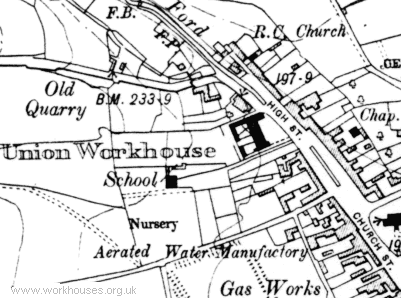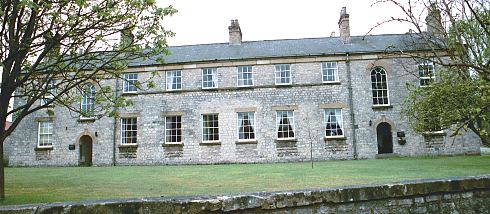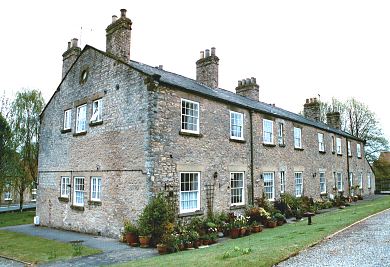Helmsley, North Riding of Yorkshire
Up to 1834
In 1773, Kirby Moorside enlarged its existing "Town House" to create a proper workhouse with the first inmates entering the following year (Chadwick, 1996).
A parliamentary report of 1777 recorded local workhouses in operation at Ampleford [Ampleforth] (with accommodation for 2 inmates), Helmsley (18 inmates), and Kirby Moor Side (20 inmates).
After 1834
Helmsley Poor Law Union (originally called Helmsley Blackmoor Union) formally came into being on 18th February 1837. Its operation was overseen by an elected Board of Guardians, 47 in number, representing its 45 constituent parishes and townships as listed below (figures in brackets indicate numbers of Guardians if more than one):
North Riding of Yorkshire: Ampleforth Birdforth, Ampleforth (Oswaldkirk Quarter), Ampleforth St Peter, Arden cum Ardenside, Beadlam, Bilsdale Midcable, Bilsdale Westside, Bransdale West Side, Byland (Coxwold), Old Byland, Cawton, Cold Kirby, Colton, Great Edstone, Little Edstone, Fadmore, Farndale East Side, Farndale Low Quarter, Farndale West Side High Quarter, Gillimore, Gilling, Grimston, Haram, Helmsley (2), North Holme, Hutton-le-Hole, Kirkby Moorside (2), Laskill Pasture, Muscoates, Nawton, East Newton and Laysthorpe, Nunnington, Oldstead, Oswaldkirk, Pockley, Rivaulx, Scawton, Skiplam, Sproxton, Stone, Thorp-le-Willows, Wass, Welburn, Wombleton.
The population falling within the union at the 1831 census had been 11,207 with parishes ranging in size from Little Edstone (population 13) to Kirkby Moorside (1,802) and Helmsley itself (1,485). The average annual poor-rate expenditure for the period 1834-36 had been £3,789 or 6s.9d. per head of the population.
Helmsley union covered a large area, much of it thinly populated bleak moorland. Much of the union was owned by Charles, Lord Feversham of Duncombe Park, a man who disliked change. His son and successor, Tory MP William Duncombe, was also strongly at odds with the 1834 Act. As a result, Helmsley union continued to use the existing old and small workhouses at Helmsley and Kirbymoorside which were "nurseries of vice and idleness". The inmates were ill-disciplined and insubordinate, and contrary to regulations the Masters of the two establishments performed their duties on a part-time basis, both having other occupations. In 1842, Feversham finally agreed to the building of a new workhouse at the north end of Pottergate in Helmsley. However, it only accommodated 35 and the building was badly constructed. A brief attempt was made to place male inmates at Helmsley where they broke stone for highway construction, and the women moved to Kirbymoorside. By 1846, the Helmsley building had 17 beds in a cold dark garret occupied by the aged and infirm, both sane and insane, and the mortuary was used by two boys as a bedroom. No work was given to the inmates.
In 1843, because of the difficulties of travel across the union for both guardians and inmates, moves began to divide the union into two. This eventually happened on 6th March, 1848, with the formation of a separate Kirkby Moorside union.
In 1850, John Wilson, previously a smallholder and cobbler, and great-grandfather of former British Prime Minister Harold Wilson, became master of the workhouse, with his wife Esther as matron. Two years later, the couple took up similar positions at the York workhouse.
A new Helmsley Union workhouse was erected in 1859-61 to accommodate 65 inmates. The building, located on the High Street in Helmsley, was designed by John and William Atkinson who were also the architects of many other Yorkshire workhouses including those at Bedale, Beverley, Easingwold, Guisborough, Goole, Howden, Kirkby Moorside, Pateley Bridge, Pocklington, Skirlaugh, Wetherby and York.
Its location is shown on the 1914 map below.

Helmsley workhouse location, 1914.
As was the case at Kirkby Moorside, the vagrants' ward at Helmsley provided neither food, running water or work.
The workhouse had closed by 1924.
The former Helmsley workhouse, now known as Woodward house, has been adapted for residential use.

Helmsley main block from the east, 2001.
© Peter Higginbotham.

Helmsley from the north-west, 2001.
© Peter Higginbotham.
Staff
Inmates
Records
Note: many repositories impose a closure period of up to 100 years for records identifying individuals. Before travelling a long distance, always check that the records you want to consult will be available.
- North Yorkshire County Record Office, Malpas Road, Northallerton DL7 8TB. Holdings: Minute books (1837-1928); Ledgers (1837-1927); Receiving officer's receipt and expenditure books (1910-29); Outdoor relief lists (1912-1926); Collector's ledger (1925-1930).
Bibliography
Links
Unless otherwise indicated, this page () is copyright Peter Higginbotham. Contents may not be reproduced without permission.


